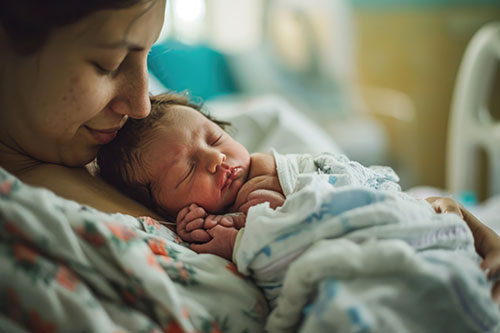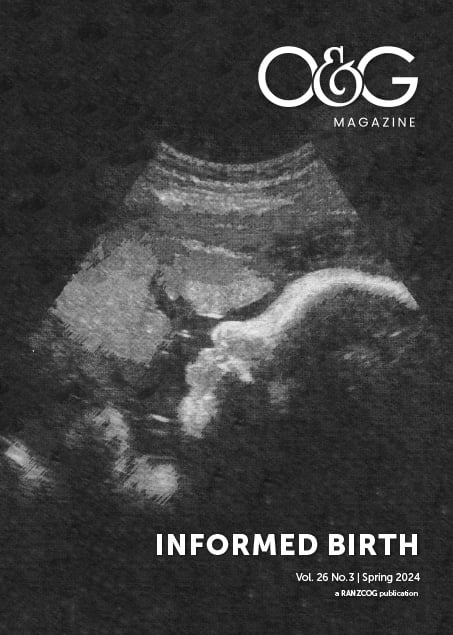Informed birth requires expectant mothers to receive clear and understandable information from healthcare providers about childbirth options and preferences. This enables them to actively engage in shared decision-making, thereby playing an active role in shaping their birthing experience.
To provide informed consent for obstetric patients we must navigate several concepts including bodily autonomy, birth philosophy, temporal decision-making, and our own biases when confronting risk and uncertainty. For both expectant mothers and their healthcare providers, managing this process requires more than medical expertise — it demands kindness and respect.
Managing risk in childbirth
In obstetrics acknowledging bodily autonomy, respects a woman’s right to make decisions about her body and health. This principle underpins informed birth, empowering women to choose their childbirth journey based on personal values and aspirations for motherhood. Alongside autonomy, societal ideals of performing “good motherhood” and confronting risk, add layers of complexity. Expectant mothers often navigate personal desires alongside cultural norms and societal and family members’ expectations.
There is no doubt that the remarkable success of modern obstetrics in reducing mortality from childbirth is based on the founding principle of identifying and managing risk. The dramatic improvement in birth morbidity and mortality seen in the 20th century occurred as interventions were introduced: standardised antenatal care, moving birth into hospitals, as well as implementing lifesaving interventions with medications, aseptic conditions and operative births. This proactive, rather than reactive, approach to risk has defined modern obstetric care ever since.
There are concerns now that in well-resourced countries like Australia, the pendulum has swung too far. Has our emphasis on reducing morbidity resulted in a system so risk averse, that it has impacted the agency of expecting mothers? Some of the overarching themes that led to the recent NSW Inquiry into Birth Trauma, arose from concerns that in current maternity care provision, “informed consent was not a priority”, and that the “focus was solely on the result of the birth and did not consider the health or the birthing experience of the mother”.1
Managing risk in childbirth has resulted in the development of two major groups of “birth philosophy”. One perspective focuses on risk and potential morbidity. From this viewpoint, opting for anything other than standard hospital-based medical care might be perceived as unconventional or harmful. Conversely, women who view pregnancy as a natural process see “alternative” options as opportunities to maintain their bodily autonomy and view the praxis of modern medicine as a departure from how an organic experience birthing should be.2 The potential clash between these two philosophies runs the risk of marginalising women in our society who have developed a mistrust of standard obstetric care practices, resulting in the free birthing movement and an even greater potential for harm.
Ultimately, while childbirth has been a physiological process for women for the last several thousand years, it unquestionably carries inherent risks. Modern society now is far less tolerant of adverse outcomes which were historically accepted in the process of birth. How people respond to uncertainty varies and is shaped by a complex interplay of influences rather than from rational assessments of risk. Given the same information, individuals are bound to make different choices to achieve a sense of control. The same applies to informed birth, where choices, are strongly influenced by temporal factors. As humans we desire for information to be confirmed by the force of experience. Experiences like previous birth, significant life events, the history of family and friends, as well as events during the pregnancy. These memories of trauma, loss, and happiness profoundly shape decision-making approaches.

Building trust
The role of an Obstetrician in advising expectant mothers in decision making, relies not only on an understanding of her experiences and the impact this has on her choices, but also on building trust. Trust can be difficult to establish, particularly in the practice of modern obstetrics with fragmented approaches to care and lack of continuity. Expectant mothers are now siphoned into low and high-risk models of care at the start of pregnancy. As risk changes or escalates in pregnancy, expectant mothers can be rapidly confronted with decisions around previously unforeseen issues, by obstetricians who they may be meeting for the first time and with whom they have not had chance to build trust or a rapport with.
We run a public clinic, catering to women with a breech baby at term. We provide an opportunity to discuss mode of delivery options and to facilitate a planned vaginal birth
if the woman makes that choice. The primary aim of this clinic is to enable women to receive evidence-based information and non-directive counselling regarding their options, which responds to their values and feelings and supports them to come to a decision which makes them feel safe and understood.
It is important to acknowledge, that while patient autonomy is crucial, its increasing emphasis can lead to harm when difficult decisions lack expert guidance.
A great deal of the consultation is spent getting to know the woman and understanding her birth philosophy. We reflect this knowledge in the counselling she is provided. This is done, by asking open-ended questions at the start of the consultation and understanding her plans for birth prior to finding out her baby was breech. Furthermore, we seek to understand what her wishes are from the visit. Ideally, the first few minutes of the consultation are spent with the expectant mother talking, and the clinicians listening and gaining insight into her values and philosophy.
An essential part of the visit also involves deconstructing the sometimes-overwhelming number of decisions to be made. In the case of our breech clinic, this involves a discussion of the first decision to be taken – whether a patient is going to proceed with an external cephalic version (ECV), which as per NSW Health policy should be offered by all maternity services. Only if the ECV is declined or fails, do we proceed to a discussion of the options for a planned vaginal breech birth versus a planned caesarean section. Otherwise, an overload of information can make it more difficult for women to prioritise their choices, hindering their ability to give informed consent. Wherever possible, we also try to allow women time to come to decisions without applying undue pressure and reaffirming our belief that we trust her to make her own decision. In our experience, the simple acknowledgment of this fact frequently opens her up to asking for our advice and trusting our line of counselling.
Another important facet of establishing trust hinges on our presentation and comfort with risk. Planned vaginal breech birth is no longer available at most maternity services in Australia. We acknowledge the particular and specific risks of a vaginal breech birth compared to an elective caesarean is an essential component of the counselling. The information is presented and discussed in a manner which doesn’t pre-empt a decision. This is essential in respecting women’s autonomy and decision-making capacity. We prefer to present absolute risk rather than the relative risk of adverse outcomes when discussing the potential for harm. We specifically reassure the woman that by far the most likely outcome of whatever decision she makes is a healthy mother and baby and that we will respect and provide care to support her. Once trust is established in this manner, patients are far more likely to appreciate guidance if it is required.
It is important to acknowledge, that while patient autonomy is crucial, its increasing emphasis can lead to harm when difficult decisions lack expert guidance. Simply providing information on childbirth options, procedures, risks, and benefits can neglect the potential for a meaningful patient-physician relationship. The value of an obstetrician in guiding decision-making relies not only on their knowledge and counselling skills but also on their compassion and empathy. Early in my training, I witnessed a senior obstetrician advising a couple facing the agonising decision of delivering twins at a peri-viable gestational age. He offered to make the decision for them if they couldn’t, a gesture of kindness and empathy that profoundly shaped my approach to patient care. In his essay Whose body is it anyway Atul Gawande asserts that “the real task isn’t to banish paternalism; the real task is to preserve kindness”.3
In obstetrics, navigating the complexities of childbirth involves more than medical expertise alone —it demands kindness, respect for autonomy, and the cultivation of trust. Achieving informed birth requires balancing medical knowledge with understanding individual values. Creating a supportive environment where expectant mothers feel empowered to make decisions based on clear information is crucial. This compassionate approach not only enhances the birthing experience but also fosters a relationship of trust and mutual respect between clinicians and patients.
References
- New South Wales. Parliament. Legislative Council. Select Committee on Birth Trauma. Report no. 1. Birth trauma “May 2024”.
- Yuill C, McCourt C, Cheyne H, et al. Women’s experiences of decision-making and informed choice about pregnancy and birth care: a systematic review and meta-synthesis of qualitative research. BMC Pregnancy Childbirth. 2020;20:343. doi:10.1186/s12884-020-03055-w.
- Gawande A. Whose body is it, anyway? The New Yorker. June 12, 2006. Available from: www.newyorker.com/magazine/2006/06/12/whose-body-is-it-anyway





Leave a Reply